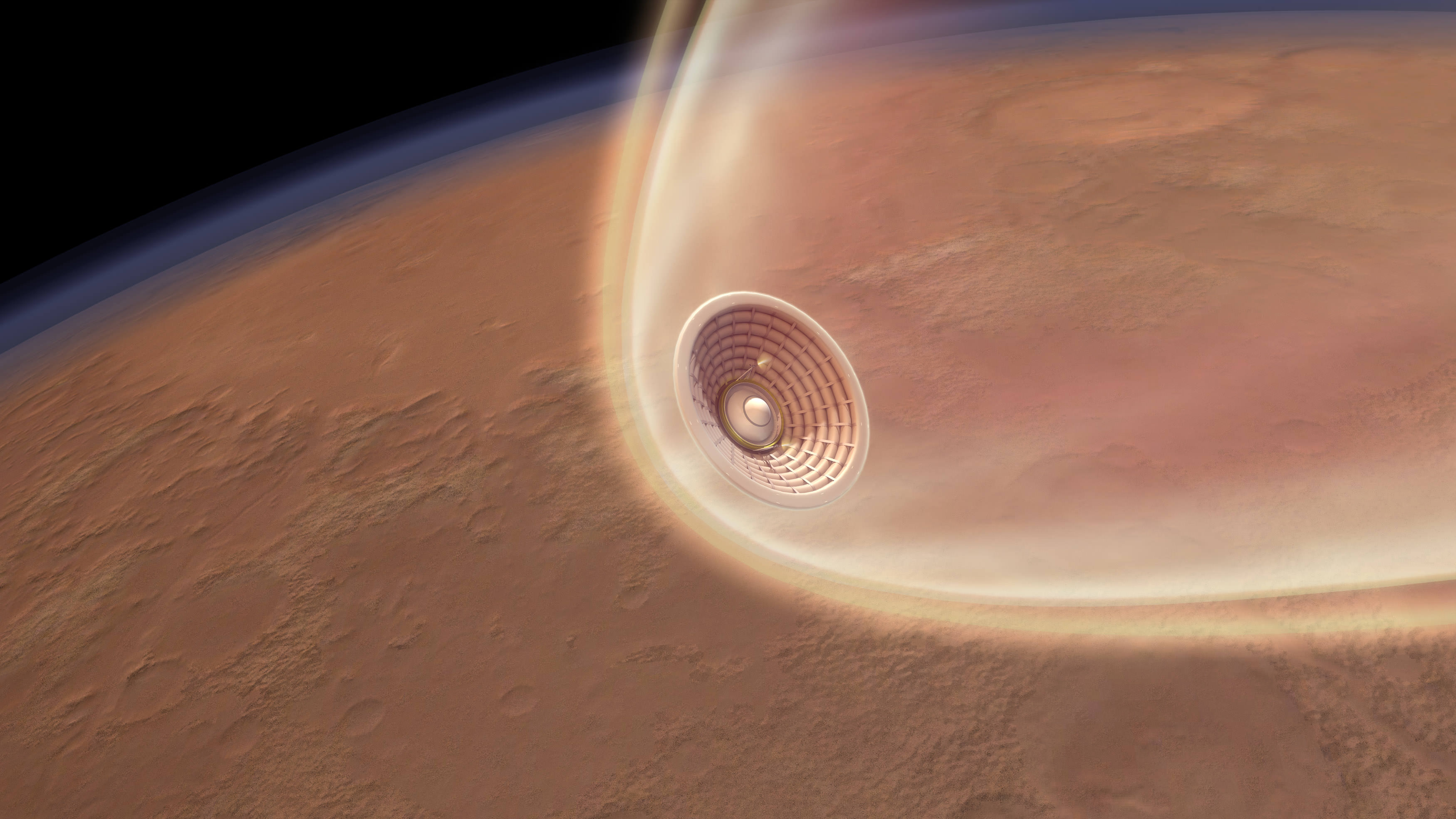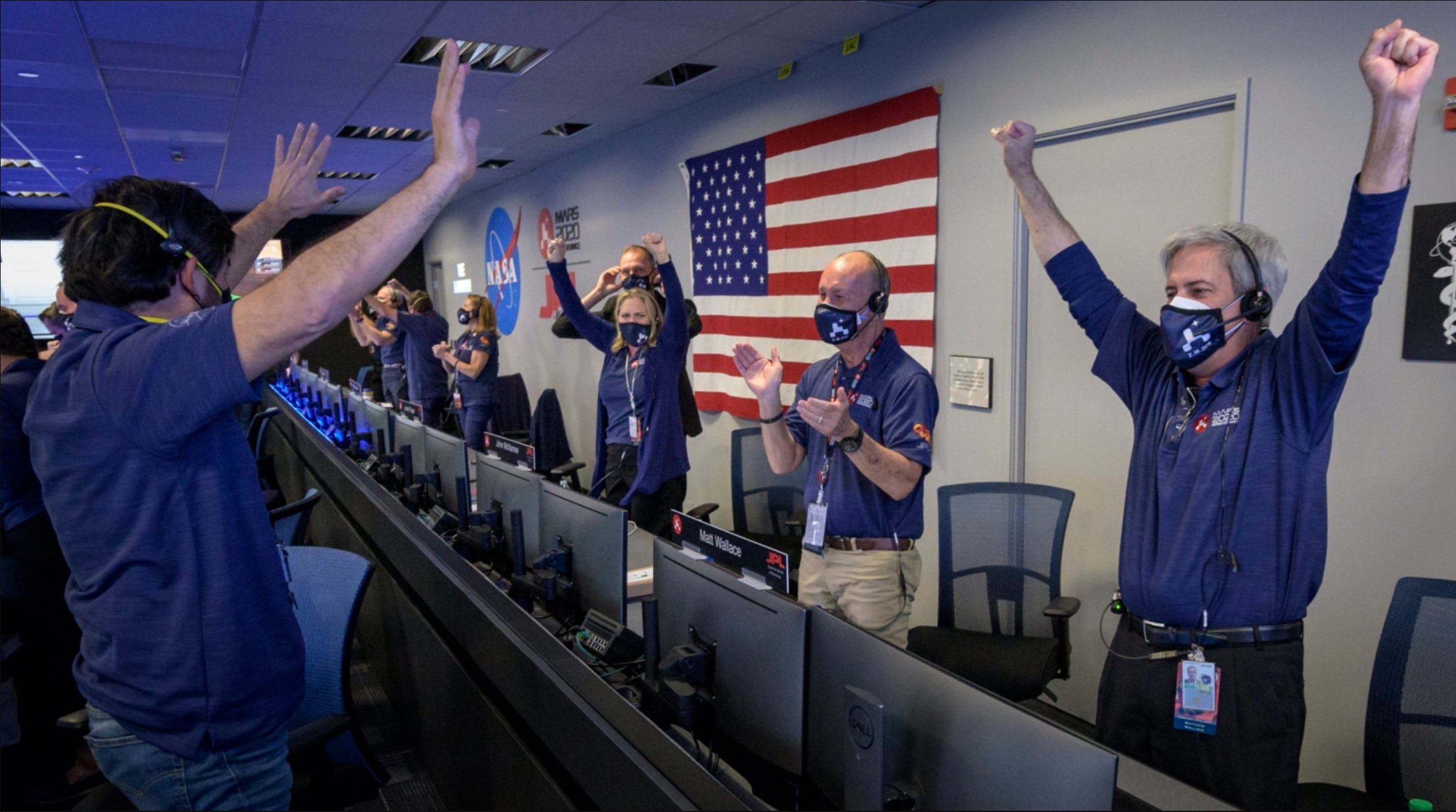Landing on Mars: Keep straight and fly right for Martian touchdown success

Getting down, dirty and securely on Mars remains a delicate balance of technical skill, mixed in with hard-earned luck.

Touching safely down on Mars is a true, nail biting event. Those terror gripping, heart-stopping moments of entry, descent, and landing (EDL) after months of cruising to the Red Planet are indeed frightening affairs.
The EDL community is busy at work on fresh ideas on how to breach Mars' atmosphere, put on the speed brakes, and plop down payloads. One big and new assignment is NASA's Mars Sample Return project and the challenges that initiative faces.
In the near and far-term, Mars is on tap to be on the receiving end of a load of landed hardware, not only to support further robotic investigations, but to reinforce a human presence on that world. But getting down, dirty and securely on Mars remains a delicate balance of technical skill, mixed in with hard-earned luck.
Related: Mars rover Perseverance spots shiny silver litter on the Red Planet (photo)
Less expensive payloads
"I see two big challenges," said Zachary Putnam, assistant professor in the Department of Aerospace Engineering at the University of Illinois at Urbana-Champaign. "Landing really big things on the surface, for more advanced robotic missions and human exploration, and landing lots of smaller, less expensive things at relatively low cost," Putnam said.
What's ahead for Mars is clear, Putnam said.
Being able to send lots of smaller payloads to the Martian surface less expensively, Putnam added, would leverage excess payload capacity on launch vehicles used to send larger payloads and take advantage of the improving abilities of small satellite technology.
Breaking space news, the latest updates on rocket launches, skywatching events and more!
"It would allow us to accept more risk, since a few failures is less of an issue if there are a lot of landers, which could help us improve all our landing technology over time," said Putnam. "Also, there's the engagement of a larger, more diverse community of scientists and engineers, such as universities."
Tallest tent pole
Alike in view is Bethany Ehlmann, a professor of planetary science at the California Institute of Technology and associate director of the Keck Institute for Space Studies in Pasadena, California.
"I think what is exciting is that Mars surface access technology is gaining new interest from companies and government technology programs," Ehlmann told Space.com. "Mars landing is the tallest tent pole in translating all of the commercial space systems investment at the moon to Mars, enabling lower cost and more frequent Mars exploration."
Ehlmann said that there is need for development at both the small size and the large size payloads. "This includes developing more cost-efficient means than sky cranes to deliver small science missions. At the large size, payloads that are human-rated also require different approaches," she said.
To Ehlmann's point, six companies received seven contracts from NASA in September to build inflatable aerodynamic decelerator systems for spacecraft entry, descent and landing operations and aerocapture missions. Potential NASA and commercial mission applications will benefit from this advanced technology.
Twice the mass
For today, it all comes back to JPL's focus for the last 20 years, said JPL's Allen Chen, Mars Sample Return (MSR) program system engineering and integration manager. "And that is to land more on Mars … and land it even more precisely than before."
In front of EDL experts is a key element of the MSR undertaking; A Sample Retrieval Lander totes with it a NASA-led Mars ascent rocket and a pair of Mars helicopters.
That lander would touch down close to the then location of Perseverance in Jezero Crater, load up with Mars collectibles and then rocket those bits and pieces (and atmospheric sample) back to Earth for detailed study.
"The Sample Retrieval Lander now weighs a little over two metric tons. That's almost twice the mass of what we put down with the Perseverance rover," Chen told Space.com. "That's a huge difference in terms of what we need to get to the ground. It's so much bigger than what we've landed before," he said.
Read more: Ingenuity helicopter on Mars heads toward ancient river delta on 31st flight
Parking space
The sky crane concept — used for the Curiosity and Perseverance Mars landings - is not in play this go-round for the Sample Retrieval Lander. Rather, the craft is to power itself down using built-in retro rockets.
As for the precise part of the MSR mission, Chen said that there's a "doubling-down" on the use of Terrain Relative Navigation (TRN), a capability that provides a map-relative position fix that can be used to accurately target specific landing points on the surface of Mars while steering clear of hazards.
Using TRN, and adding a lot of fuel to the Sample Retrieval Lander, will allow the craft to land within 60 meters or better of a target. "We have to land an even bigger vehicle in a particular parking lot … in a particular parking space," Chen said.
Additionally, an adaptive range trigger is to enable an even smarter self-decision about when the lander deploys its parachute.
And there's more. The lander's parachute itself is growing to an 80-foot (24-meter) design. "We want to beef up the parachute to be able to handle the load of a much bigger vehicle," said Chen.
Rocket plume ruckus
The Mars Perseverance rover is already pre-scouting the landscape to help ascertain that primo parking space for a touch down. "For the first time we can see everything that's of a concern to the lander," Chen said. "We'll know exactly what's there and that's a huge advantage."
The goal is to land within a couple hundred meters of where the Perseverance rover will be, or a locale where the wheeled robot can easily drive up to deliver Mars specimens to the Sample Retrieval Lander. Care will be taken not to land directly near Perseverance, Chen said, due to concern about the ruckus created when the lander's rocket plume pitches out surface rock and sand.
"Given what we have right now, and the need to land a huge amount of mass very precisely, what you're seeing for us is a big step, but really an evolution of what we have been doing in the past. We're excited for the opportunity to show what we can do," Chen concluded.
Kink in the curve
Since the early 1990s, Rob Manning, now chief engineer at Jet Propulsion Laboratory, has been actively engaged in plotting out EDL at Mars.
As for the MSR effort ahead, "I won't say the word is risk because I don't know how to quantify the risks, but there are a lot of developmental challenges," Manning said. "I hope we don't bump into new physics."
In looking beyond MSR, Manning said there's a "kink in the curve" for EDL.
"Supersonic Retro Propulsion is a whole new game," Manning said. Supersonic retro propulsion, SRP for short, is a method to decelerate a vehicle using retrorockets in the supersonic regime.
"I think the big step function in the future is taking a stab and try SRP on Mars, and actually get that to work. I think it will work. Everyone agrees that it could work. It's just that we're all kind of chicken," said Manning.
Complicated phenomenon
SRP work at JPL has benefited by cooperation with SpaceX and Elon Musk, the company's chief. "They've allowed us to monitor the quality of their booster returns which fly exactly in the right domain," Manning said, noting complicated phenomenon, like the interaction of rocket plume with the supersonic wake that's being generated around the re-entering booster.
"It's so hard to get your arms around it computationally … very hard to analyze," Manning said.
For the EDL community there's much work ahead in terms of new research, new know-how and hardware to showcase new capabilities.
"Especially the push by MSR, the Sample Retrieval Lander fits squarely between where we've going with the large landing system and where we are going after that, in human scale," Manning said.
Follow us on Twitter @Spacedotcom or on Facebook.

Leonard David is an award-winning space journalist who has been reporting on space activities for more than 50 years. Currently writing as Space.com's Space Insider Columnist among his other projects, Leonard has authored numerous books on space exploration, Mars missions and more, with his latest being "Moon Rush: The New Space Race" published in 2019 by National Geographic. He also wrote "Mars: Our Future on the Red Planet" released in 2016 by National Geographic. Leonard has served as a correspondent for SpaceNews, Scientific American and Aerospace America for the AIAA. He has received many awards, including the first Ordway Award for Sustained Excellence in Spaceflight History in 2015 at the AAS Wernher von Braun Memorial Symposium. You can find out Leonard's latest project at his website and on Twitter.




